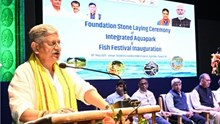
Desertification and Drought Day 2020, a United Nations observance day held on 17 June each year, will in 2020 focus on changing public attitudes to the leading driver of desertification and land degradation: humanity’s relentless production and consumption.
Almost 75% of the land has been transformed from natural state globally due to increasing demand for food, feed and fibre. Land degradation caused by unsustainable production and consumption calls for radical change in our lifestyles. The livestock sector is one of the key drivers of land-use change. Each year, 13 billion hectares of forest are lost to land conversion for agricultural use such as pasture and cropland. This has a negative effect on water availability, biodiversity and climate.
Ibrahim Thiaw, Executive Secretary of the UN Convention to Combat Desertification said, “If we keep producing and consuming, as usual, we will eat into the planet’s capacity to sustain life until there is nothing left but scraps. We all need to make better choices about what we eat and what we wear to help protect and restore the land.”

United Nations Convention to Combat Desertification (UNCCD) is a Convention to combat desertification and mitigate the effects of drought through national action programs that incorporate long-term strategies which started on 17 June 1994 and entered into force in December 1996. Desertification and Drought Day 2020, is running under the slogan “Food. Feed. Fibre.” seeks to provoke changes in diet and behaviours such as cutting food waste, buying from local markets and swapping clothes instead of always buying new can free up land for other uses and lower carbon emissions. Changing consumer and corporate behaviour, having more efficient planning and sustainable practices, could secure enough land to meet the demand for food and supplies. Grammy winner Ricky Kej has composed a jingle for 2020 UNCCD Desertification and Drought Day.
Grethel Aguilar, IUCN Acting Director-General in a video message said, “Healthy people depend on healthy soil and healthy landscapes. Promoting more biodiversity in agriculture can help address food insecurity, land degradation and climate change.” Plants and animals provide most of our food, clothing and footwear. This means that food, (animal) feed and fibre (for clothing) all compete for arable land. And demand is growing due to population growth and increasing global middle classes.

It is also estimated that the fashion industry produces more emissions than the airline industry. It will also require 35% more land by 2030. So it is advised that responsible brands and consumers call for more sustainable practices to cut emissions plus reduce pressure on land. Even it is urged to donate your old clothes for a sustainable future and the protection of natural recourses. New social media challenge has been posted saying “Let's post art to help save Earth's 1 million threatened species!" All these efforts will help in achieving Goal 15 of Sustainable Development Goals (SDGs) which is life on the land which states that “ Protect, restore and promote sustainable use of terrestrial ecosystems, sustainably manage forests, combat desertification, and halt and reverse land degradation and halt biodiversity loss. A flourishing life on land is the foundation for our life on this planet. By 2030, combat desertification, restore degraded land and soil, including land affected by desertification, drought and floods, and strive to achieve a land degradation-neutral world.”

What we can do:
- Eat a balanced diet, featuring plant-based foods like coarse grains, legumes, fruits and vegetables, nuts and seeds. This will improve your health, reduce demand for agricultural land and water, contribute to climate change mitigation and adaptation and preserve habitats.
- Ensure the meat you consume is grown ethically and sustainably, ideally from animals that are fed locally.
- Look for locally grown produce in the groceries in the supermarket to support local farmers and reduce the carbon footprint of the food from the farm to their table.
- Reduce food waste by buying only what you need, planning your meals and donating excess non-perishables to local food banks.
- Plant fruit trees in schoolyards, communal parks or in your home for a healthy snack within easy reach. Even you can start growing vegetables in your garden or pots.
- Make compost at home and use it in your own or community gardens instead of chemical pesticides and fertilizers.
- Repair, donate, swap clothes and avoid fast-fashion, to save water and prevent contamination of natural resources.
- Use a handkerchief instead of disposable tissues.
- Plant green roofs to cool homes in the summer and prevent heat loss in the winter, thus reducing your carbon footprint.
Consumers can make a positive difference because government policy and suppliers are extremely sensitive to individual market choices. If every consumer were to buy products that do not degrade the land, suppliers will cut back the flow of these products, and send a powerful signal to the producer of the change needed to stay in business. Thus it’s your planet let’s make it beautiful with sustainable developments and a secured future.
















